Understanding Multi-Hazard Interactions and Impacts on Small-Island Communities: Insights from the Active Volcano Island of Ternate, Indonesia
Abstract
1. Introduction
2. Multi-Hazard Assessment: Concepts and Approaches
2.1. Basic Definition
2.2. Interaction and Risk Assessment
3. Materials and Methods
3.1. Geographical Context and Hazard Risk on Ternate Island
3.1.1. Hydro-Meteorological Hazards on Ternate Island
3.1.2. Geological Hazards on Ternate Island
3.2. Multi-Hazard Interaction Assessment
3.2.1. Multi-Hazard Risk Assessment
Generating Individual Hazard and Integrated Hazard Maps
Generating Population Density and Land Use Maps
Generating Multi-Hazard Risk Map
3.3. Multi-Hazard Matrix Assessment
3.4. Survey
4. Results
4.1. The Level of Individual Hazard Zones
4.1.1. Hydro-Meteorological Hazards
4.1.2. Geological Hazards
4.2. The Level of Integrated Hazard Zone
4.3. Population Density, Land Use, and Vulnerability Maps
4.4. Multi-Hazard Risk Assessment
4.5. Multi-Hazard Interaction Matrix
4.6. Village Chiefs’ Perception of Hazards
5. Discussion
6. Final Remarks
6.1. Conclusions
- Given the island’s limited land area and the increase in population density and concentration of infrastructure, spatial planning must consider the risks posed by many hazards, including potential losses in future extreme climate events.
- More risk awareness and risk communication are imperative in areas where local communities, especially the village leaders, undermine the risk of natural hazards. The multi-hazard mapping results indicate that the impact of multi-hazards is becoming more extensive and encompasses the entire territory of Ternate Island, including both hydro-meteorological and all other hazards. This map is demonstrated by the substantial proportion of land classified as high-risk, which accounts for up to 61% of the entire area of Ternate Island.
- Multi-hazard zonation in small-island communities (SICs) is a fundamental step in managing disaster risk. It provides information about the location and severity of individual hazards. It allows the government and all stakeholders to prioritize and address the most critical hazards, allocate resources effectively, and develop a more resilient system to handle multi-hazard scenarios.
6.2. Limitation and Future Work
Supplementary Materials
Author Contributions
Funding
Institutional Review Board Statement
Informed Consent Statement
Data Availability Statement
Conflicts of Interest
References
- Lamichhane, S.; Aryal, K.R.; Talchabhadel, R.; Thapa, B.R.; Adhikari, R.; Khanal, A.; Pandey, V.P.; Gautam, D. Assessing the Prospects of Transboundary Multihazard Dynamics: The Case of Bhotekoshi–Sunkoshi Watershed in Sino–Nepal Border Region. Sustainability 2021, 13, 3670. [Google Scholar] [CrossRef]
- Safaei, S.; Stepayan, M.; Houdijk; Onur, T. National Disaster Risk Assessment: Words into Action Guidelines Governance System, Methodologies, and Use of Results; United Nations Office for Disaster Risk Reduction (UNISDR): Geneva, Switzerland, 2017.
- De Angeli, S.; Malamud, B.D.; Rossi, L.; Taylor, F.E.; Trasforini, E.; Rudari, R. A multi-hazard framework for spatial-temporal impact analysis. Int. J. Disaster Risk Reduct. 2022, 73, 102829. [Google Scholar] [CrossRef]
- Bordbar, M.; Aghamohammadi, H.; Pourghasemi, H.R.; Azizi, Z. Multi-hazard spatial modeling via ensembles of machine learning and meta-heuristic techniques. Sci. Rep. 2022, 12, 1451. [Google Scholar] [CrossRef]
- Liu, B.; Siu, Y.L.; Mitchell, G. Hazard interaction analysis for multi-hazard risk assessment: A systematic classification based on hazard-forming environment. Nat. Hazards Earth Syst. Sci. 2016, 16, 629–642. [Google Scholar] [CrossRef]
- Kappes, M.S.; Keiler, M.; von Elverfeldt, K.; Glade, T. Challenges of analyzing multi-hazard risk: A review. Nat. Hazards 2012, 64, 1925–1958. [Google Scholar] [CrossRef]
- Sudmeier-Rieux, K.; Paleo, U.F.; Garschagen, M.; Estrella, M.; Renaud, F.G.; Jaboyedoff, M. Opportunities, incentives and challenges to risk sensitive land use planning: Lessons from Nepal, Spain and Vietnam. Int. J. Disaster Risk Reduct. 2015, 14, 205–224. [Google Scholar] [CrossRef]
- Roslan, A.F.; Fernando, T.; Biscaya, S.; Sulaiman, N. Transformation towards Risk-Sensitive Urban Development: A Systematic Review of the Issues and Challenges. Sustainability 2021, 13, 10631. [Google Scholar] [CrossRef]
- Alikaei, S.; Rahmani, M.; Jamalabadi, F.; Akdogan, M.E.; Khoshnevis, S. Multi-hazard based land use planning in isolated area; learning from the experience of Pul-e-Khumri City, Afghanistan. Sustain. Cities Soc. 2023, 99, 104873. [Google Scholar] [CrossRef]
- Qutb, S. Environmental Risk—Sensitive Assessment Methodology for Sustainable Land Use Planning in New Egyptian Communities (Case study: New Sphinx City). SVU-Int. J. Eng. Sci. Appl. 2021, 2, 37–47. [Google Scholar] [CrossRef]
- Rogger, M.; Agnoletti, M.; Alaoui, A.; Bathurst, J.C.; Bodner, G.; Borga, M.; Chaplot, V.; Gallart, F.; Glatzel, G.; Hall, J.; et al. Land use change impacts on floods at the catchment scale: Challenges and opportunities for future research. Water Resour. Res. 2017, 53, 5209–5219. [Google Scholar] [CrossRef]
- Tilloy, A.; Malamud, B.D.; Winter, H.; Joly-Laugel, A. A review of quantification methodologies for multi-hazard interrelationships. Earth-Sci. Rev. 2019, 196, 102881. [Google Scholar] [CrossRef]
- Dunant, A. Are We Missing the Target? A Bias-Variance Perspective on Multi-Hazard Risk Assessment. Front. Earth Sci. 2021, 9, 685301. [Google Scholar] [CrossRef]
- Robinson, S.-A. A commentary on national adaptation drivers: The case of small island developing states. Clim. Change 2019, 154, 303–313. [Google Scholar] [CrossRef]
- Thompson, D.D.P. Compounding challenges for disaster resilience in small island developing states. Disaster Prev. Resil. 2022, 1, 4. [Google Scholar] [CrossRef]
- Abenir, M.A.D.; Manzanero, L.I.O.; Bollettino, V. Community-based leadership in disaster resilience: The case of small island community in Hagonoy, Bulacan, Philippines. Int. J. Disaster Risk Reduct. 2022, 71, 102797. [Google Scholar] [CrossRef]
- Hadi, S.; Widayani, S.; Mulyo, S.A. Rencana Induk Penanggulangan Bencana 2015–2045; Jati, R., Ed.; Pusat Data, Informasi dan Hubungan Masyarakat, Badan Nasional Penanggulangan Bencana: Jakarta, Indonesia, 2018.
- Badan Pusat Statistik Kota Ternate. Kota Ternate Dalam Angka 2024; 1102001.8271; Badan Pusat Statistik: Ternate, Indonesia, 2024.
- Badan Perencanaan Pembangunan Penelitian dan Pembangunan Daerah. Revisi Rencana Tata Ruang Wilayah Kota Ternate Tahun 2012–2032; Pemerintah Kota Ternate, Maluku Utara: Kota Ternate, Indonesia, 2017.
- Latue, P.C. Analisis Spasial Temporal Perubahan Tutupan Lahan di Pulau Ternate Provinsi Maluku Utara Citra Satelit Resolusi Tinggi. Buana J. Geogr. Ekol. Dan. Kebencanaan 2023, 1, 31–38. [Google Scholar] [CrossRef]
- OpenAI. Response to Query about Multi-Hazard Disaster Risk. Available online: https://chat.openai.com/chatgpton22/05/2024 (accessed on 24 May 2024).
- Ravankhah, M.; Schmidt, M.; Will, T. Multi-hazard disaster risk identification for World Cultural Heritage sites in seismic zones. J. Cult. Herit. Manag. Sustain. Dev. 2017, 7, 272–289. [Google Scholar] [CrossRef]
- Terzi, S.; Torresan, S.; Schneiderbauer, S.; Critto, A.; Zebisch, M.; Marcomini, A. Multi-risk assessment in mountain regions: A review of modelling approaches for climate change adaptation. J Environ. Manag. 2019, 232, 759–771. [Google Scholar] [CrossRef]
- Liu, Z.; Nadim, F.; Garcia-Aristizabal, A.; Mignan, A.; Fleming, K.; Luna, B.Q. A three-level framework for multi-risk assessment. Georisk Assess. Manag. Risk Eng. Syst. Geohazards 2015, 9, 59–74. [Google Scholar] [CrossRef]
- Gill, J.C.; Malamud, B.D. Reviewing and visualizing the interactions of natural hazards. Rev. Geophys. 2014, 52, 680–722. [Google Scholar] [CrossRef]
- van Westen, C.J.; Greiving, S. Multi-hazard risk assessment and decision making. In Environmental Hazards Methodologies for Risk Assessment; Dalezios, N.R., Ed.; IWA Publishing: London, UK, 2017; Volume 1, pp. 31–91. [Google Scholar]
- Marzocchi, W.; Garcia-Aristizabal, A.; Gasparini, P.; Mastellone, M.L.; Di Ruocco, A. Basic principles of multi-risk assessment: A case study in Italy. Nat. Hazards 2012, 62, 551–573. [Google Scholar] [CrossRef]
- Nejedlik, P.; Dalezios, N.R. Hazards information management and services. In Environmental Hazards Methodologies for Risk Assessment and Management, 1st ed.; Dalezios, N.R., Ed.; IWA Publishing: London, UK, 2017. [Google Scholar]
- Barua, U.; Akhter, M.S.; Ansary, M.A. District-wise multi-hazard zoning of Bangladesh. Nat. Hazards 2016, 82, 1895–1918. [Google Scholar] [CrossRef]
- Abdulwahid, W.M.; Pradhan, B. Landslide vulnerability and risk assessment for multi-hazard scenarios using airborne laser scanning data (LiDAR). Landslides 2016, 14, 1057–1076. [Google Scholar] [CrossRef]
- Buck, K.D.; Summers, J.K. Application of a Multi-Hazard Risk Assessment for Local Planning. Geomat. Nat. Hazards Risk 2020, 11, 2058–2078. [Google Scholar] [CrossRef] [PubMed]
- Aksha, S.K.; Resler, L.M.; Juran, L.; Carstensen, L.W. A geospatial analysis of multi-hazard risk in Dharan, Nepal. Geomat. Nat. Hazards Risk 2020, 11, 88–111. [Google Scholar] [CrossRef]
- Carpignano, A.; Golia, E.; Di Mauro, C.; Bouchon, S.; Nordvik, J.P. A methodological approach for the definition of multi-risk maps at regional level: First application. J. Risk Res. 2009, 12, 513–534. [Google Scholar] [CrossRef]
- Mutaqin, B.W.; Handayani, W.; Rosaji, F.S.C.; Wahyuningtyas, D.; Marfai, M.A. Geomorphological Analysis for the Identification of Small Islands in North Maluku, Indonesia. J. Geogr. 2021, 13, 184–194. [Google Scholar] [CrossRef]
- Mutaqin, B.W.; Marfai, M.A.; Hadmoko, D.S.; Lavigne, F.; Faral, A.; Wijayanti, H.; Riasasi, W.; Sri Sumantyo, J.T.; White, B.; Cardenas Tristan, A.; et al. Geomorphology of the small island of Tidore and Hiri (North Maluku, Indonesia). E3S Web Conf. 2021, 325, 03012. [Google Scholar] [CrossRef]
- Nagu, N.; Lessy, M.R.; Achmad, R. Adaptation Strategy of Climate Change Impact on Water Resources in Small Island Coastal Areas: Case Study on Ternate Island-North Maluku. KnE Soc. Sci. 2018, 3, 424–441. [Google Scholar] [CrossRef]
- Firmansyah. Identifikasi tingkat risiko bencana letusan Gunung Api Gamalama di Kota Ternate. J. Lingkung. Dan Bencana Geol. 2011, 2, 203–219. [Google Scholar]
- Hidayat, A.; Marfai, M.A.; Hadmoko, D.S. Eruption Hazard and Challenges of Volcanic Crisis Management on a Small Island: A Case Studi on Ternate Island—Indonesia. Int. J. GEOMATE 2020, 18, 171–178. [Google Scholar] [CrossRef]
- Umanailo, H.A.; Franklin, P.J.C.; Waani, J.O. Perkembangan Pusat Kota Ternate (Studi Kasus: Kecamatan Ternate Tengah). Spasial 2017, 4, 222–233. [Google Scholar]
- Kosuma, S.; Palar, S.W.; Lapian, A.L.C.P. Analisis Struktur Perekonomian dan Pertumbuhan Ekonomi di Kota Ternate. J. Berk. Ilm. Efisiensi 2016, 16, 507–513. [Google Scholar]
- Badan Nasional Penanggulangan Bencana. Dokumen Kajian Risiko Bencana Kota Ternate Provinsi Maluku Utara; Badan Nasional Penanggulangan Bencana: Jakarta, Indonesia, 2012.
- Ervita, K.; Marfai, M.A.; Khakhim, N. Pemetaan Kerawanan Tsunami dan Perubahan Garis Pantai di Pulau-Pulau Kecil (Study Kasus: Pulau Vulkanik Kecil Ternate). In Proceedings of the Seminar Nasional MPPDAS ke 4 Tahun 2018, Universitas Gadjah Mada, Yogjakarta, Indonesia, 28 October 2018. [Google Scholar]
- Sabaruddin, S.; Rasyid, R. Utilization of QGIS 3.22 with a Spatial Approach in Assessing Tsunami Risk on Small Islands in Ternate City. Techno J. Penelit. 2023, 12, 84–89. [Google Scholar] [CrossRef]
- Angkotasan, A.M.; Nurjaya, I.W.; Natih, N.M.N. Analisis Perubahan Garis pantai di Pantai Barat Daya Pulau Ternate, Provinsi Maluku Utara. J. Teknol. Perikan. Dan Kelaut. 2012, 3, 11–22. [Google Scholar] [CrossRef]
- Sofyan, A.; Dudibiyakto; Latif, S. Kajian Erosi Marine Sebagai Penyebab Degradasi Kepesisiran Kota Ternate. J. Mns. Dan Lingkung. 2010, 17, 89–97. [Google Scholar]
- Lessy, M.R.; Abdullah, R.M. Forecasting of Significant Wave Height and Period at Western Waters of Ternate Island, North Maluku. Techno J. Penelit. 2021, 10, 17–26. [Google Scholar] [CrossRef]
- Hidayat, A.; Marfai, M.A.; Hadmoko, D.S. The 2015 eruption of Gamalama volcano (Ternate Island–Indonesia): Precursor, crisis management, and community response. GeoJournal 2020, 87, 1–20. [Google Scholar] [CrossRef]
- Ikqra; Tjahjono, B.; Sunarti, E. Geomorphological Study of Ternate Island and Landslide Hazard Assessment. J. Ilmu Tanah Lingkung. 2012, 14, 1–6. [Google Scholar] [CrossRef]
- Ikqra. Analisis Bentuk Lahan (landform) untuk Penilaian Bahaya dan Risiko Longsor di Pulau Ternate Provinsi Maluku Utara. J. Dialog. Penanggulangan Bencana 2013, 4, 99–110. [Google Scholar]
- Sulaeman, C.; Cipta, A. Model intensitas gempa bumi di Maluku Utara Earthquake Intensity Model in North Maluku. J. Lingkung. Dan Bencana Geol. 2012, 3, 79–88. [Google Scholar]
- Masinu, A.L.; Yustesia, A.; Suwardi. Sistem Tektonik Dan Implikasinya Terhadap Gempa Bumi Di Pulau Halmahera. J. Pendidik. Geogr. 2018, 23, 20–29. [Google Scholar] [CrossRef][Green Version]
- Nasarudin; Suwo, R.; Kasnar, S. Analisis Kesiapsiagaan Masyarakat Pada Wilayah Rawan Banjir Lahar Dingin Gunung Gamalama Kelurahan Dufa-Dufa Ternate. J. Spasial 2019, 6, 43–49. [Google Scholar]
- Priambodo, Y.A.; Kamis, M. Delineasi DAS Sungai Penyebab Banjir di Kelurahan Rua Kecamatan Pulau Ternate Kota Ternate Manggunakan HEC-HMS. J. Sipil Sains 2020, 10, 151–156. [Google Scholar]
- Lessy, M.R.; Arif, A.K.; Marassabessy, F.; Wahyuningrum, R.; Nagu, N. Kapasitas Adaptif Masyarakat di Wilayah Pesisir Terhadap Bencana (Studi Kasus Bencana Banjir di Kelurahan Bastiong Karance Kota Terante). In Proceedings of the Prosiding Seminar Nasional Kemaritiman dan Sumberdaya Pulau-Pulau Kecil, Ternate, Indonesia, 3 October 2016; pp. 77–85. [Google Scholar]
- Sabrina, V.; Azka, M.A.; Sugianto, P.A. Kajian meteorologis Saat kejadian bencana Hidrometeorologis di Maluku Utara (Studi Kasus: 15–16 Januari 2021). J. Widya Climago 2021, 3, 53–60. [Google Scholar]
- Masinu, A.L.; Riva, M.; Mane, D.L. Fenomena Gunung Api Gamalama Terhadap Dampak Aliran Lahar. J. Pendidik. Geogr. 2018, 23, 113–121. [Google Scholar] [CrossRef]
- Pradiptasari, A.G.; Waani, J.O.; Mononimbar, W. Sistem Penanggulangan Bencana Gunung Api Gamalama di Permukiman Kampung Tubo Kota Ternate. Spasial Perenc. Wil. Dan. Kota 2015, 2, 33–42. [Google Scholar]
- Supartoyo. Gempa Bumi Laut Maluku Tanggal 15 November 2014. J. Lingkung. Dan Bencana Geol. 2015, 6, 45–58. [Google Scholar]
- Brilliantina, M.V.; Pratiwi, H.; Susanti, Y. Analisis Seismisitas pada Data Gempa Bumi di Provinsi Maluku Utara: Penerapan Model Epidemic Type Aftershock Sequence (ETAS). In Proceedings of the Prosiding Pendidikan Matematika dan Matematika, Universiyas Negeri Yogjakarta, Depok, Indonesia, 9 May 2021. [Google Scholar] [CrossRef]
- Saifuddin, A.; Pertiwi, E.I. Pemetaan Zona Resiko Gempabumi Berdasarkan Peak Ground Acceleration Terhadap Energi Dan Sumberdaya Mineral Di Provinsi Maluku Utara. In Proceedings of the Seminar Nasional Geomatika: Informasi Geospasial Untuk Inovasi Percepatan Pembangunan Berkelanjutan Bogor, Jakarta, Indonesia, 15–16 October 2020. [Google Scholar]
- Hamzah, L.; Puspito, N.T.; Imamura, F. Tsunami Catalog and Zones in Indonesia. J. Nat. Disaster Sci. 2000, 22, 25–43. [Google Scholar] [CrossRef]
- Wipulanusat, W.; Nakrod, S.; Prabnarong, P. Multi-hazard Risk Assessment Using GIS and RS Applications: A Case Study of Pak Phanang Basin. Walailak J. Sci. Technol. WJST 2011, 6, 109–125. [Google Scholar]
- Dilley, M.; Chen, R.S.; Deichmann, U.; Lerner-Lam, A.L.; Arnold, M.; Agwe, J.; Buys, P.; Kjekstad, O.; Lyon, B.; Yetman, G. Natural Disaster Hotspots: A Global Risk Analysis; The World Bank: Washington, DC, USA, 2005. [Google Scholar]
- Greiving, S. Integrated Risk Assessment of Multi-hazards: A New Methodology. Geol. Surv. Finl. 2006, 42, 75–82. [Google Scholar]
- Gill, J.C.; Malamud, B.D. Hazard interactions and interaction networks (cascades) within multi-hazard methodologies. Earth Syst. Dyn. 2016, 7, 659–679. [Google Scholar] [CrossRef]
- Fleischhauer, M.; Greiving, S.; Schlusemann, B.; Schmidt-Thomé, P.; Kallio, H.; Tarvainen, T.; Jarva, J. Multi-risk assessment of spatially relevant hazards in Europe. In Proceedings of the ESMG Symposium, Nürnberg, Germany, 11–13 October 2005. [Google Scholar]
- Badan Nasional Penanggulangan Bencana. Peraturan Kepala Badan Penanggulangan Bencana Tentang Pedoman Umum Pengkajian Risiko Bencana; BNPB: Jakarta, Indonesia, 2012.
- Bonadonna, C.; Frischknecht, C.; Menoni, S.; Romerio, F.; Gregg, C.E.; Rosi, M.; Biass, S.; Asgary, A.; Pistolesi, M.; Guobadia, D.; et al. Integrating hazard, exposure, vulnerability and resilience for risk and emergency management in a volcanic context: The ADVISE model. J. Appl. Volcanol. 2021, 10, 7. [Google Scholar] [CrossRef] [PubMed]
- Depietri, Y.; Dahal, K.; McPhearson, T. Multi-hazard risks in New York City. Nat. Hazards Earth Syst. Sci. 2018, 18, 3363–3381. [Google Scholar] [CrossRef]
- De Pippo, T.; Donadio, C.; Pennetta, M.; Petrosino, C.; Terlizzi, F.; Valente, A. Coastal hazard assessment and mapping in Northern Campania, Italy. Geomorphology 2008, 97, 451–466. [Google Scholar] [CrossRef]
- Choi, E.; Ha, J.-G.; Hahm, D.; Kim, M.K. A review of multihazard risk assessment: Progress, potential, and challenges in the application to nuclear power plants. Int. J. Disaster Risk Reduct. 2021, 53, 101933. [Google Scholar] [CrossRef]
- Badan Penanggulangan Bencana Daerah Kota Ternate. Data Kejadian Bencana Kota Ternate Tahun 2020–2021; Badan Penanggulangan Bencana Daerah Kota Ternate: Ternate, Indonesia, 2021.
- Shalih, O.; Adi, A.W.; Wiguna, S.; Shabrina, F.Z.; Rizqi, A.; Putra, A.S.; Karimah, R.; Eveline, F.; Alfian, A.; Syauqi; et al. Risiko Bencana Indonesia “Memahami Risiko Sistemik di Indonesia”, 1st ed.; Pusat Data Informasi dan Komunikasi Kebencanaan, Badan Nasional Penanggulangan Bencana (BNPB): Jakarta, Indonesia, 2023.
- Rasai, J.; Muslim, D.; Sulaksana, N.; Setiadi, D. Korelasi Air Limpasan dengan Perubahan Sungai Tugurara Sebagai Ancaman bencana di Kota ternate Provinsi maluku Utara. J. Dialog. Penanggulangan Bencana 2017, 8, 120–131. [Google Scholar]
- Mei, E.T.W.; Mardianto, D.; Pamudianti, E.; Amalia, D.Y. Physical Assessment of Barangka Tugurara Towards Volcanic Hazards of Gamalama Volcano. In Proceedings of the 1st International Conference on Geography and Education (ICGE 2016), Malang, Indonesia, 29 October 2016; pp. 1–6. [Google Scholar]
- Yudhicara; Lukman, S. Temuan Endapan Paleotsunami di Pulau Ternate: Bersiap untuk Selamat. J. Geol. Dan Sumberd. Miner. 2024, 25, 41–53. [Google Scholar] [CrossRef]
- Saputra, H.; Hasyim, A.W.; Rachmansyah, A. Penataan Kawasan Bencana Lahar Dingin Di Kecamatan Ternate Tengah Dan Ternate Utara. Indones. Green Technol. J. 2015, 4, 1–10. [Google Scholar]
- Girma, F.A. Analyising Open Source Python Based Tools for Multihazards Risk Assessment; University of Twente: Enschede, The Netherlands, 2021. [Google Scholar]
- Hall, R. Indonesia Geology. In Encyclopedia of Islands, 2nd ed.; Gillespie, R., Claugue, D., Eds.; Encyclopedias of the Natural World; University of Californis Press: Berkely, LA, USA; London, UK, 2009; pp. 454–459. [Google Scholar]
- Anwar, S. Perbandingan Nilai Hazard Kejadian Tsunami di Indonesia Berdasarkan Posisi Garis Khatulistiwa (Katalog Tsunami Indonesia 1802–2018). J. Environ. Geol. Hazards 2018, 12, 33–45. [Google Scholar] [CrossRef]
- Horspool, N.; Pranantyo, I.; Griffin, J.; Latief, H.; Natawidjaja, D.H.; Kongko, W.; Cipta, A.; Bustaman, B.; Anugrah, S.D.; Thio, H.K. A probabilistic tsunami hazard assessment for Indonesia. Nat. Hazards Earth Syst. Sci. 2014, 14, 3105–3122. [Google Scholar] [CrossRef]
- Aldrian, E.; Dwi Susanto, R. Identification of three dominant rainfall regions within Indonesia and their relationship to sea surface temperature. Int. J. Climatol. 2003, 23, 1435–1452. [Google Scholar] [CrossRef]
- Elake, A.Y.; Talahatu, M.; Nanlohy, P. Korelasi Multivariabel Enso, Monsun Dan Dipolemode Terhadap Variabilitas Curah Hujan Di Maluku. Barekeng J. Ilmu Mat. Dan Terap. 2018, 12, 7–16. [Google Scholar] [CrossRef][Green Version]
- Kurnio, H.; Naibaho, T.; Purwanto, C. Review of Submarine Landslides in the Eastern Indonesia Region. Bull. Mar. Geol. 2019, 34, 63–76. [Google Scholar] [CrossRef]
- Gissing, A.; Timms, M.; Browning, S.; Crompton, R.; McAneney, J. Compound natural disasters in Australia: A historical analysis. Environ. Hazards 2021, 21, 159–173. [Google Scholar] [CrossRef]
- Sarihi, Y.R.; Tilaar, S.; Rengkun, M.M. Analisis Penggunaan Lahan di Kota Ternate. J. Spasial 2020, 7, 259–269. [Google Scholar]
- Aryuni, V.T.; Salam, R.; Farida, A. Prediksi Kebutuhan Area Permukikan di Kota Ternate. Space 2021, 8, 111–122. [Google Scholar]
- Marasabessy, F. Hirarki Wilayah Kota Ternate Pasca Pengembangan Kawasan Waterfront City. J. Wil. Dan Lingkung. 2016, 4, 213–224. [Google Scholar] [CrossRef][Green Version]
- Said, M. Reklamasi dan dampaknya Terhadap Wilayah Pesisir Pantai Toboko, Kota Ternate. Dintek 2019, 12, 83–91. [Google Scholar]
- Greiving, S.; Fleischhauer, M.; Lückenkötter, J. A Methodology for an integrated risk assessment of spatially relevant hazards. J. Environ. Plan. Manag. 2006, 49, 1–19. [Google Scholar] [CrossRef]
- Jani, M.; Zauhar, S.; Saleh, C.; Domai, T. Spatial Planning in the Perspective of Sustainable Development Goals (SDGs): Case Study on Ternate, North Maluku, Indonesia. Hong Kong J. Social. Sci. 2023, 60, 978–989. [Google Scholar] [CrossRef]
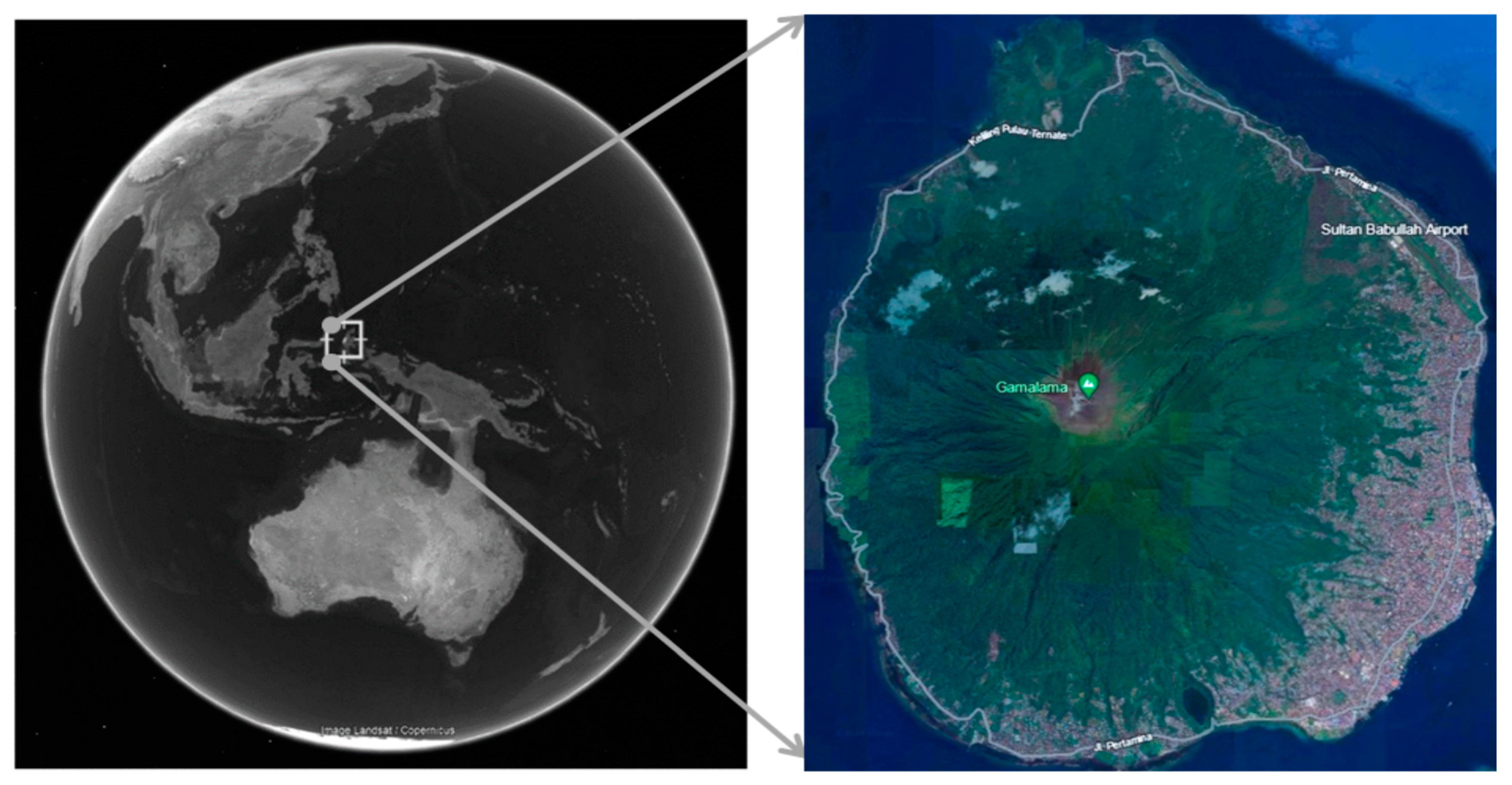

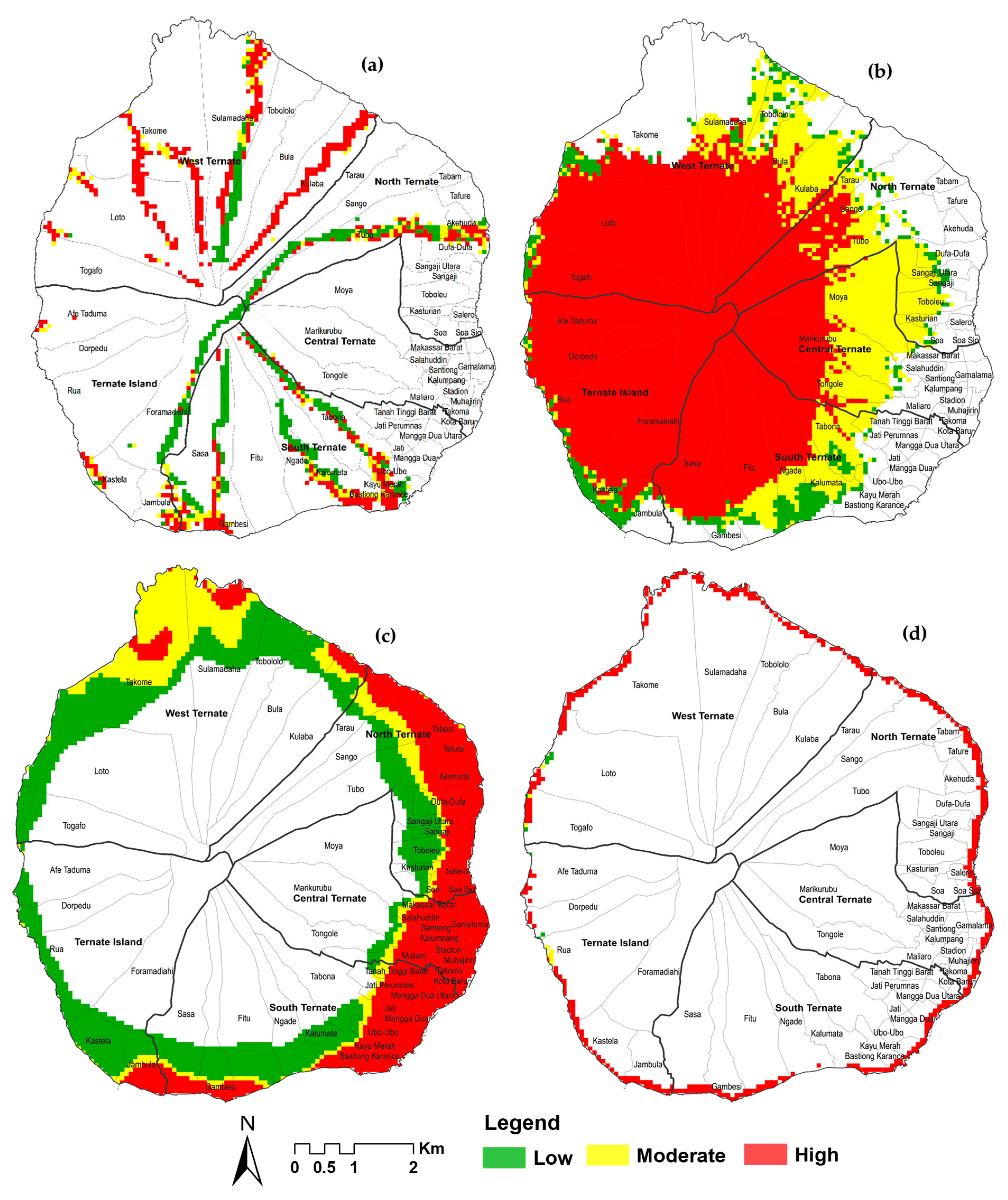
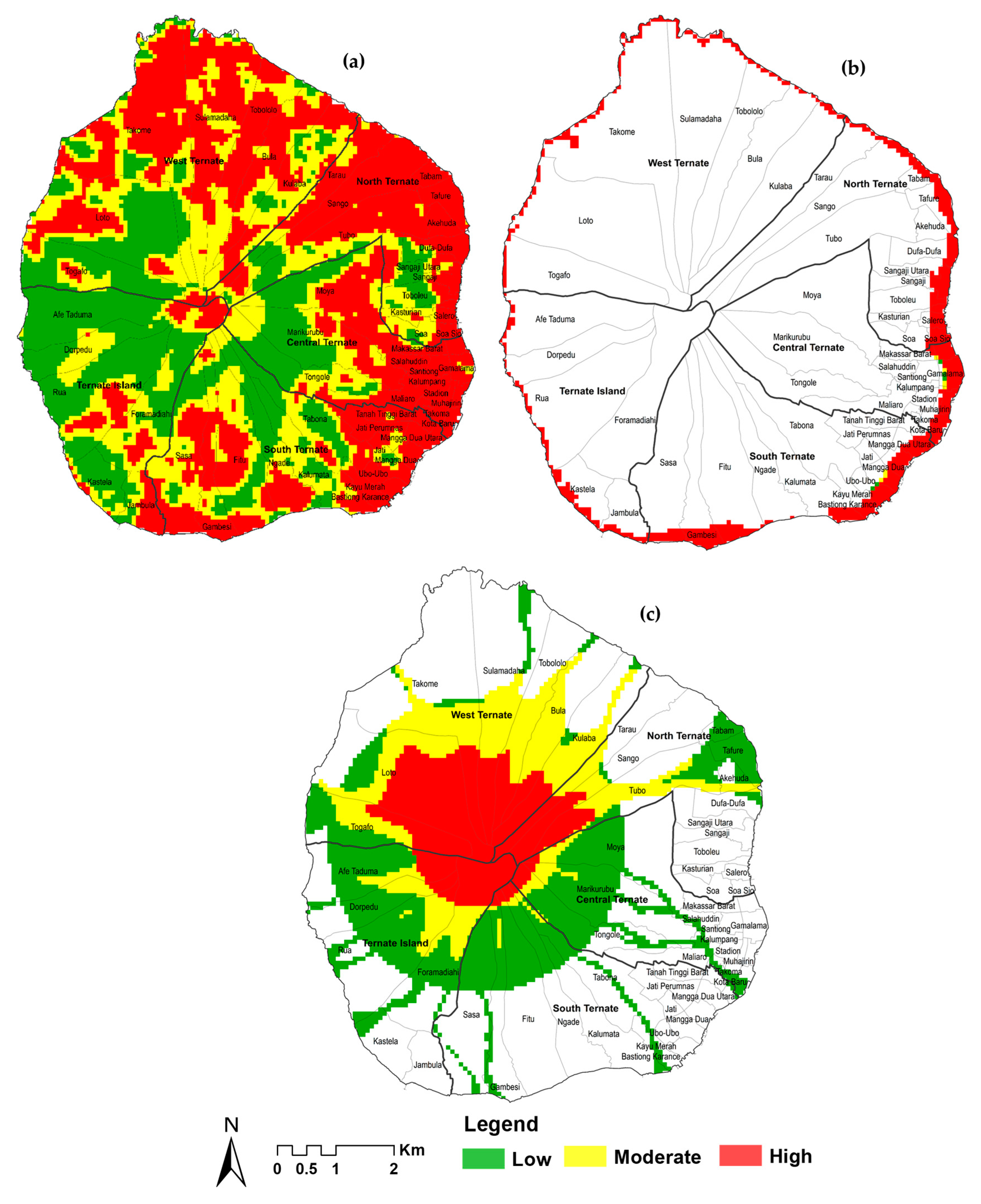
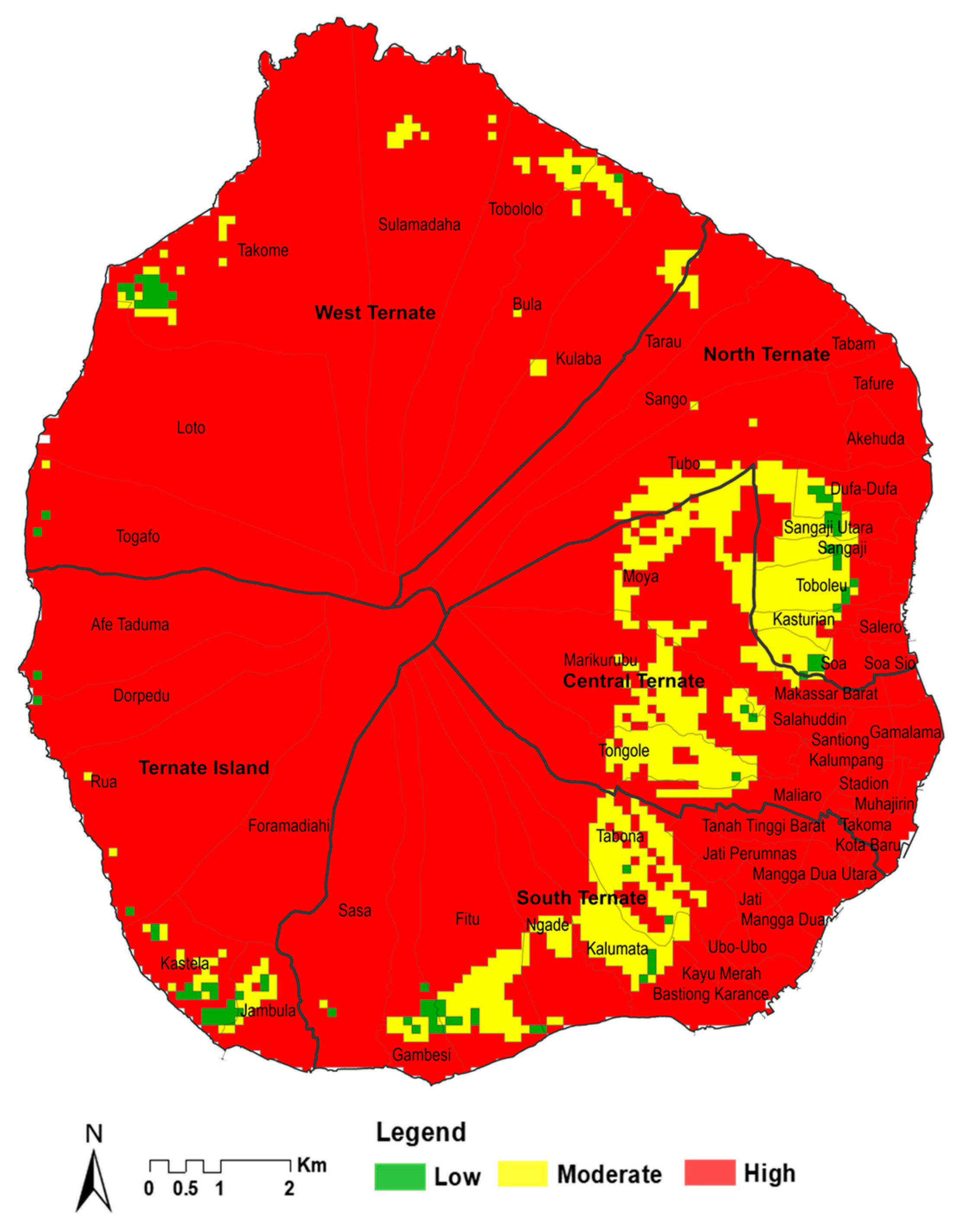
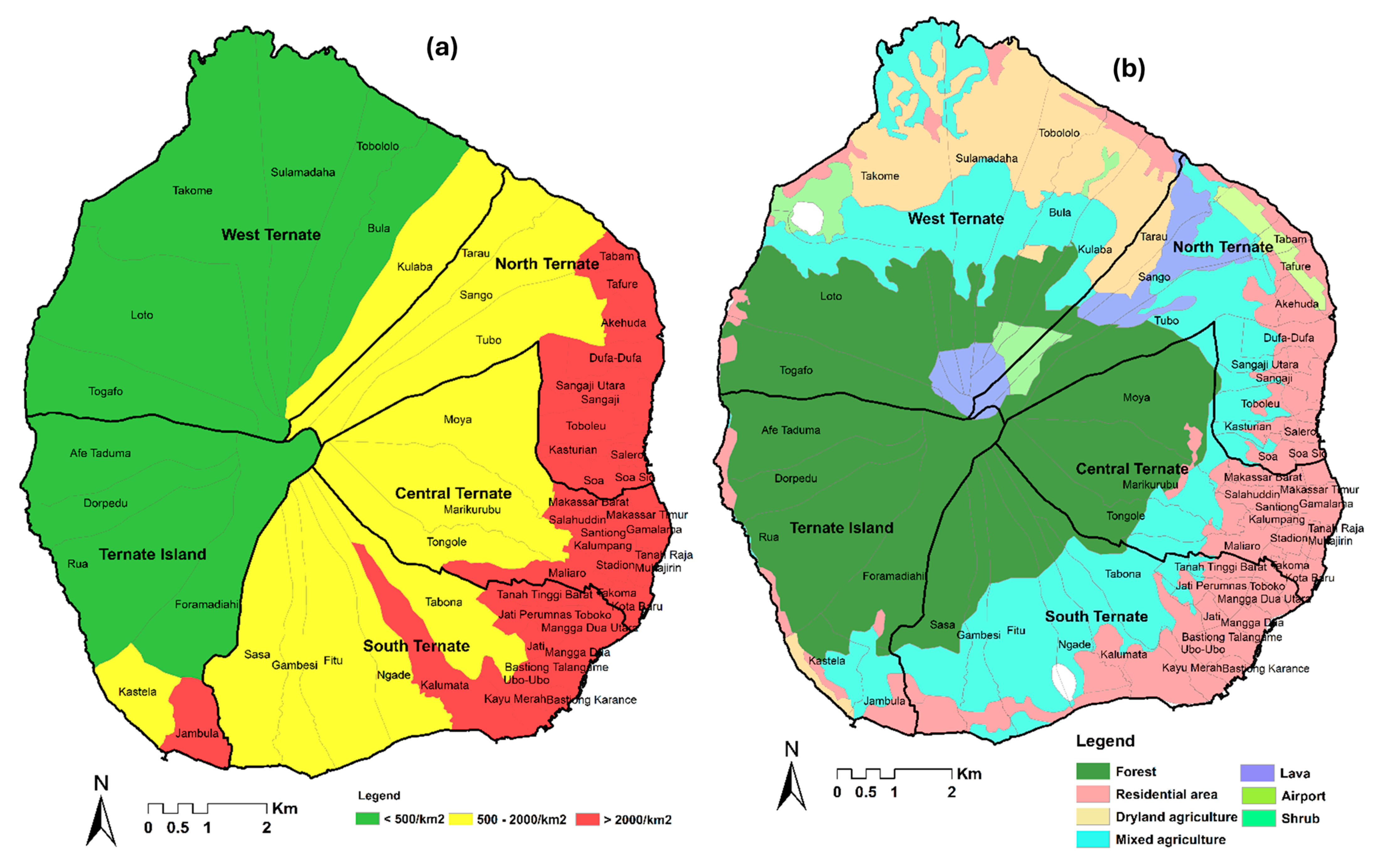
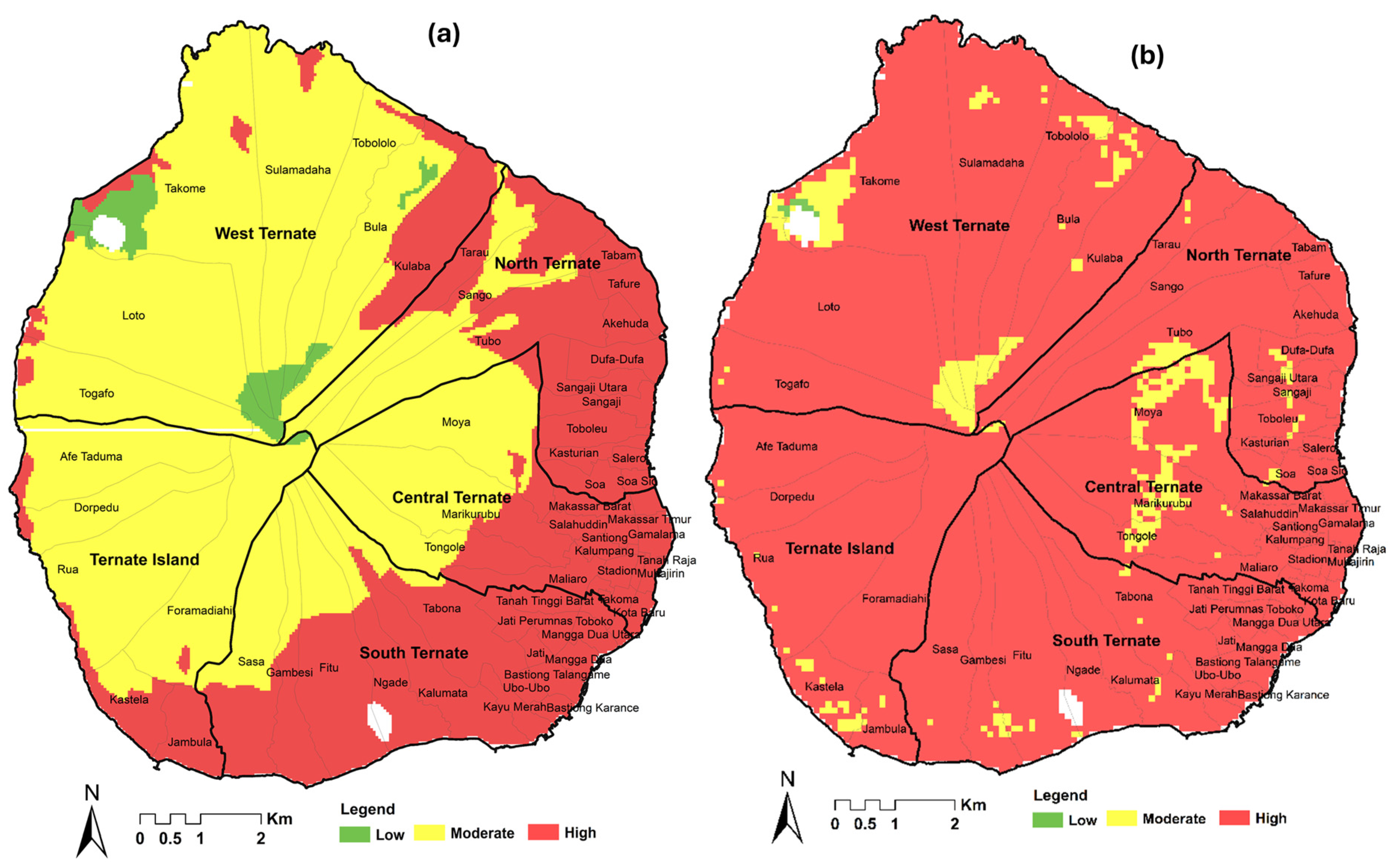
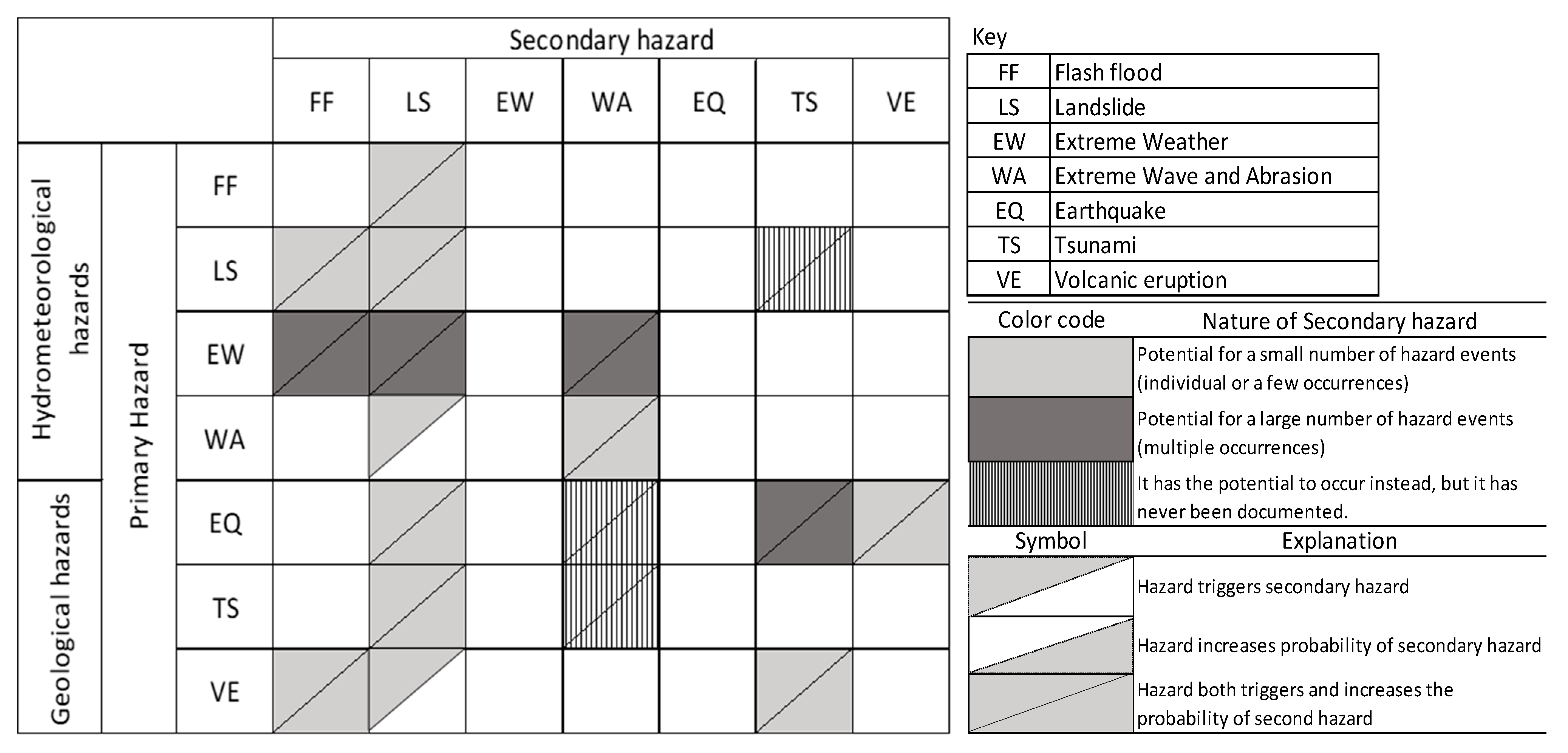
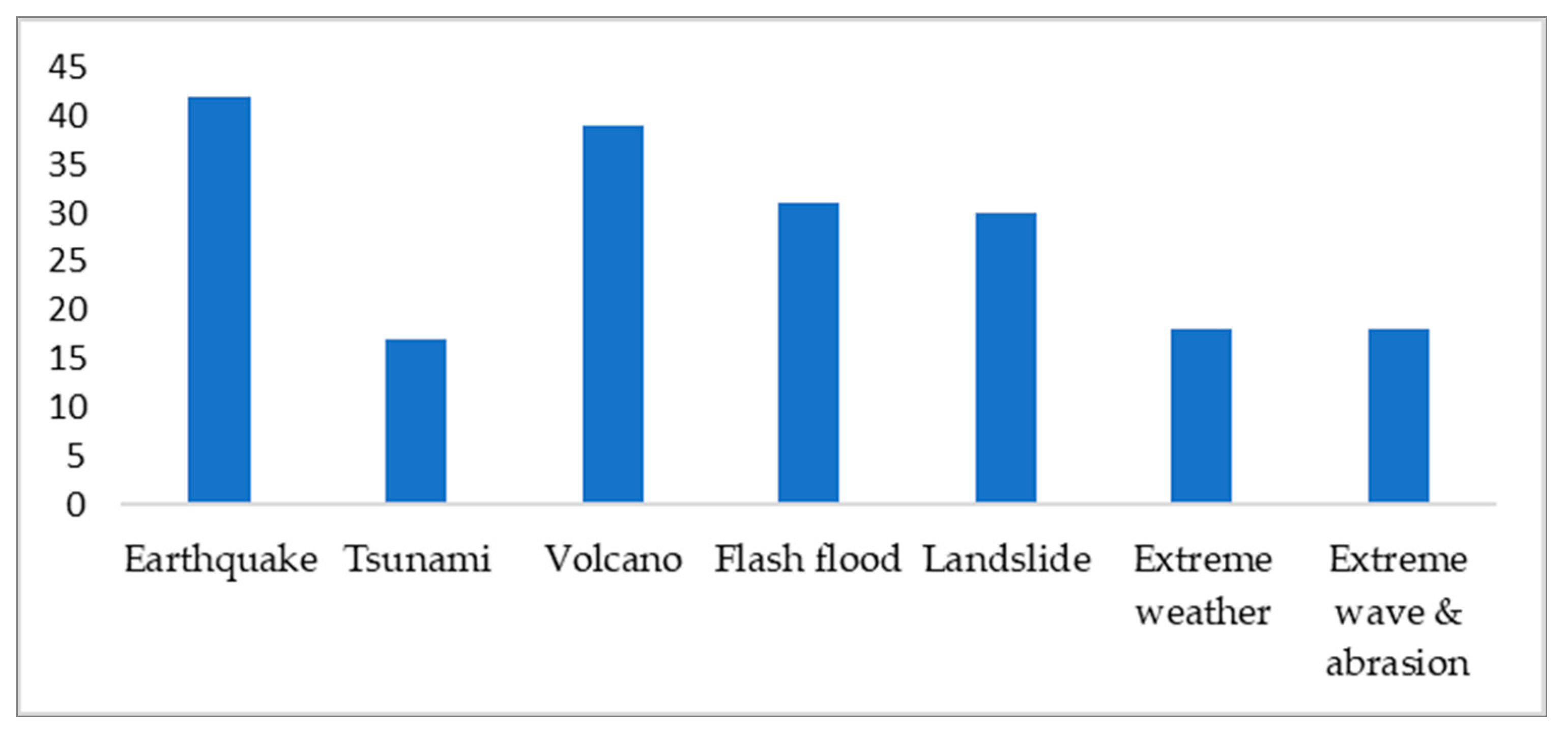
| Source | Interaction Type |
|---|---|
| Gill and Malamud 2014 [25] |
|
| Liu et al., 2016 [5] |
|
| Van Westen and Greving 2017 [26] |
|
| Tilloy et al., 2019 [12] |
|
| De Angeli et al., 2022 [3] |
|
| Hazard | Weighting | Index Class | Ranking |
|---|---|---|---|
| Population density (/km2) | 0.5 | <500 | 1 |
| 500–2000 | 2 | ||
| >2000 | 3 | ||
| Land use type | 0.5 | forest/shrub | 1 |
| agriculture | 2 | ||
| residential area | 3 |
| Sub-District | Flash Flood (ha) | Landslide (ha) | Extreme Weather (ha) | Extreme Wave and Abrasion (ha) | ||||||||
|---|---|---|---|---|---|---|---|---|---|---|---|---|
| L | M | H | L | M | H | L | M | H | L | M | H | |
| North Ternate | 88 | 44 | 66 | 62 | 379 | 347 | 273 | 135 | 531 | 0 | 0 | 95 |
| Central Ternate | 4 | 1 | 5 | 13 | 544 | 471 | 42 | 32 | 325 | 0 | 0 | 36 |
| South Ternate | 189 | 80 | 157 | 160 | 328 | 990 | 378 | 85 | 500 | 0 | 0 | 90 |
| West Ternate | 70 | 58 | 328 | 137 | 482 | 1816 | 701 | 487 | 120 | 6 | 3 | 139 |
| Ternate Island | 78 | 22 | 38 | 95 | 38 | 1508 | 318 | 26 | 49 | 2 | 6 | 64 |
| Total Area | 428 | 205 | 593 | 466 | 1771 | 5133 | 1711 | 764 | 1526 | 8 | 9 | 424 |
| Sub-District | Earthquake (ha) | Tsunami (ha) | Volcano Eruption (ha) | ||||||
|---|---|---|---|---|---|---|---|---|---|
| L | M | H | L | M | H | L | M | H | |
| North Ternate | 164 | 351 | 1029 | 0 | 0 | 169 | 440 | 111 | 191 |
| Central Ternate | 383 | 345 | 676 | 0 | 0 | 108 | 369 | 365 | 240 |
| South Ternate | 439 | 656 | 890 | 5 | 6 | 188 | 563 | 320 | 165 |
| West Ternate | 709 | 1093 | 1566 | 0 | 1 | 82 | 399 | 130 | 127 |
| Ternate Island | 1016 | 429 | 241 | 0 | 0 | 130 | 380 | 507 | 485 |
| Total Area | 2710 | 2874 | 4402 | 5 | 7 | 677 | 2151 | 1432 | 1208 |
| Sub-District | Multi-Hazard Exposure Areas (ha) | Total (ha) | ||
|---|---|---|---|---|
| L | M | H | ||
| North Ternate | 22 | 245 | 1306 | 1573 |
| Central Ternate | 4 | 297 | 1104 | 1404 |
| South Ternate | 25 | 274 | 1749 | 2047 |
| West Ternate | 21 | 85 | 3270 | 3376 |
| Ternate Island | 25 | 38 | 1654 | 1717 |
| Total area | 97 | 938 | 9083 | 10,118 |
| Sub-District | Male | Female | Population | Household | Density |
|---|---|---|---|---|---|
| North Ternate | 24,535 | 24,093 | 48,628 | 14,744 | 3493 |
| Central Ternate | 26,999 | 27,179 | 54,178 | 16,603 | 4086 |
| South Ternate | 35,613 | 35,466 | 71,079 | 21,265 | 3515 |
| West Ternate | 4560 | 4540 | 9100 | 2567 | 269 |
| Ternate Island | 4424 | 4303 | 8727 | 2578 | 502 |
| Total | 96,131 | 95,581 | 191,712 | 57,757 |
| Sub-District | Area (ha) | Total (ha) | ||
|---|---|---|---|---|
| L | M | H | ||
| North Ternate | 1 | 485 | 1095 | 1581 |
| Central Ternate | 0 | 801 | 605 | 1405 |
| South Ternate | 0 | 517 | 1505 | 2022 |
| West Ternate | 198 | 2759 | 398 | 3355 |
| Ternate Island | 6 | 1447 | 252 | 1704 |
| total | 204 | 6008 | 3854 | 10,067 |
| Sub-District | Area (ha) | Total (ha) | ||
|---|---|---|---|---|
| L | M | H | ||
| North Ternate | 0 | 57 | 1516 | 1572 |
| Central Ternate | 0 | 164 | 1241 | 1405 |
| South Ternate | 0 | 28 | 1991 | 2019 |
| West Ternate | 9 | 239 | 3091 | 3338 |
| Ternate Island | 0 | 35 | 1675 | 1710 |
| Total | 9 | 522 | 9513 | 10,044 |
| Primary Hazard | Secondary Hazard | Type of Interaction | Occurrence | Source |
|---|---|---|---|---|
| Flash Flood | Landslide | Triggering/Cascading | 28 February 2020, at Bula village; 27 July 2020, at Tobololo village; 25 January 2021, at Fitu village; 12 April 2021, at Salahuddin village | [72] |
| Landslide | Flash flood | Triggering/Cascading | occurred in 2011 and 2012 at Tubo village | [56,74,75] |
| Extreme weather (heavy rain) | Flood/Landside | Compound hazard | 19 June 2020, at Takome village; 16 September 2020, at Rua village; 15 October 2020, at Tabam village; 14 November 2020, at Bastiong Talangame village; 30 November 2020, at Makassar Barat village; 19 January 2021, at Jati village; 15 June 2021, at Soa village | [72] |
| Extreme weather (strong wind) | High wave | Triggering/Cascading | occurred in 2021 | [55] |
| Extreme weather (strong wind) | High wave/Abrasion | Compound hazard | occurred in coastal area of Ternate Island; 5 August 2020, at Sulamadaha village; 1 February 2021, at Tafure village | [44,45,46,72] |
| Extreme Wave and Abrasion | Landslide | Triggering/Cascading | 24 August 2020, at Sulamadaha village; 8 March 2021, at Togafo village | [48,72] |
| Earthquake | Tsunami | Triggering/Cascading | North Maluku area; Ternate Island | [60,61,76] |
| Earthquake | Tsunami/Landslide | Triggering/Cascading | Ternate island | [76] |
| Earthquake | Volcano eruption | Triggering/Cascading | Ternate island | [47] |
| Volcano eruption | Flash Flood | Triggering/Cascading | occurred in 2011 and 2012 at Tubo village | [56,74,77] |
| Volcano eruption | Tsunami | Triggering/Cascading | Ternate island | [76] |
Disclaimer/Publisher’s Note: The statements, opinions and data contained in all publications are solely those of the individual author(s) and contributor(s) and not of MDPI and/or the editor(s). MDPI and/or the editor(s) disclaim responsibility for any injury to people or property resulting from any ideas, methods, instructions or products referred to in the content. |
© 2024 by the authors. Licensee MDPI, Basel, Switzerland. This article is an open access article distributed under the terms and conditions of the Creative Commons Attribution (CC BY) license (https://creativecommons.org/licenses/by/4.0/).
Share and Cite
Lessy, M.R.; Lassa, J.; Zander, K.K. Understanding Multi-Hazard Interactions and Impacts on Small-Island Communities: Insights from the Active Volcano Island of Ternate, Indonesia. Sustainability 2024, 16, 6894. https://doi.org/10.3390/su16166894
Lessy MR, Lassa J, Zander KK. Understanding Multi-Hazard Interactions and Impacts on Small-Island Communities: Insights from the Active Volcano Island of Ternate, Indonesia. Sustainability. 2024; 16(16):6894. https://doi.org/10.3390/su16166894
Chicago/Turabian StyleLessy, Mohammad Ridwan, Jonatan Lassa, and Kerstin K. Zander. 2024. "Understanding Multi-Hazard Interactions and Impacts on Small-Island Communities: Insights from the Active Volcano Island of Ternate, Indonesia" Sustainability 16, no. 16: 6894. https://doi.org/10.3390/su16166894
APA StyleLessy, M. R., Lassa, J., & Zander, K. K. (2024). Understanding Multi-Hazard Interactions and Impacts on Small-Island Communities: Insights from the Active Volcano Island of Ternate, Indonesia. Sustainability, 16(16), 6894. https://doi.org/10.3390/su16166894







